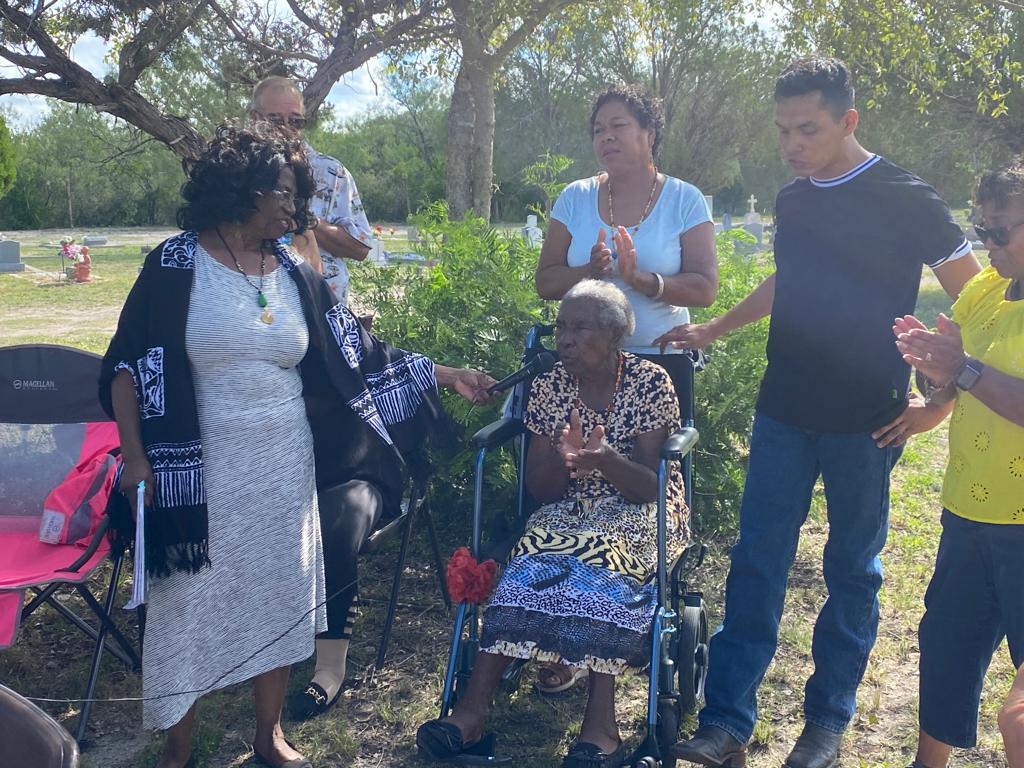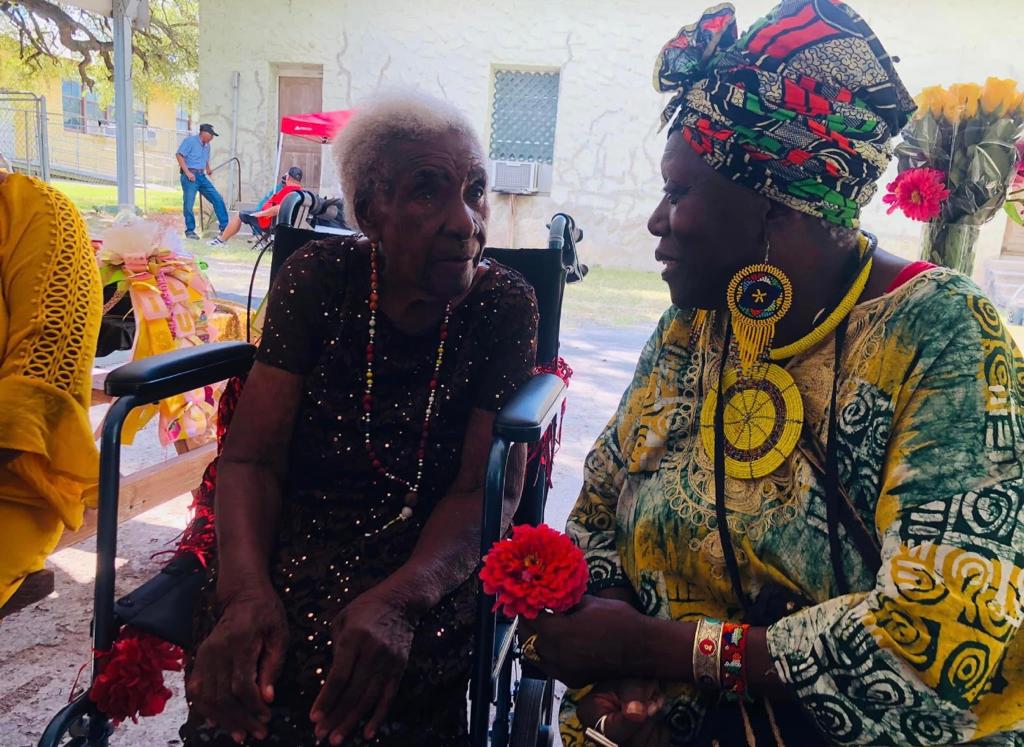Why We Sing
Windy Goodloe[1]
Seminole Indian Scouts Cemetery Association
Wade in the water
Wade in the water, children
Wade in the water
God’s gonna trouble the water…

Doña Lucía singing This may be my last time in the cemetery
Photo by: Windy Goodloe
The first time I heard that song, I didn’t understand what it meant, but I knew that it had affected me deeply. I knew that it was different from the songs I’d heard on the radio. I knew that it made me feel differently than the songs I’d heard on the radio. I must confess. “Wade in the Water” is one of my favorite songs — period. It was a song I’d heard sung during Seminole Days and Juneteenth and at church when I was a little girl, along with “This Little Light of Mine,” the Negro National Anthem, and several others.
In the world that we live in today, we can pull up any song that we want instantly on our phones or on our computers. For example, just the other day, while I was at the Plaza del Sol mall in Del Rio, a song that I hadn’t heard in years came on as I was exiting, and by the time I got to the car, I had downloaded the song, and I was able to listen to it several times on the drive home. We are so lucky to live in a time where music is so accessible. When we want to set a certain mood, all we have to do is go to Spotify or Apple Music. Music, personally, has been an integral part of my existence for as long as I can remember. So much so that I studied it while I was in college. I was and still am obsessed with jazz, particularly John Coltrane, Miles Davis, and Billie Holiday. And it was while I was in college that I first learned about the depth that some music possesses. I had amazing music professors who stressed the importance of both technical proficiency and fostering an intimate, emotional relationship with the material being performed. In learning about the history of music, I was dumbfounded when I learned that the first instrument was not the drum or an early version of a piano, flute, or guitar. The first instrument was the human voice. The human voice. Think about that. As soon as our ancient ancestors learned to make guttural sounds, they also began to make melodic sounds. They used their voices to do things like communicate with each other, to pass the time, and to soothe crying or sleepy babies. Our voices have traversed not only centuries but millennia, and our voices remain one of the most important testaments of our existence. We have carried our voices with us for our whole existence, and we must continue to carry and use our voices as instruments of record and change. In learning all of this, I couldn’t help but wonder, Why did they sing? And why do we sing?
Doña Lucía and Makeda Dread

Photo by Corina Torralba
The history of the Negro spiritual begins in the motherland. In Africa, music was infused in every aspect of everyday life. Songs were sung to celebrate births, deaths, and weddings. Songs were also sung as they worked. Along with the voice, the drum was another important instrument used as a form of communication. Rhythms were created to signal births, deaths, and to send various other types of messages. By using drums, Africans created a form of communication that was to be envied, and it rivaled almost any other form of communication that existed at that time.
Now, imagine being forced into a situation that was not of your choosing. Imagine having your home, your drum, and life as you know it snatched away from you. Imagine being stolen away from all that you know and love. Imagine being packed like sardines into a ship, where you embarked on a three to four-month journey that would take you into the very bowels of hell. If you survived, when you reached this new destination, you were told that your language, your beliefs, your way of life were no longer yours. Instead a new language, a new set of beliefs, and a new way of life were forced upon you. But one thing that was not taken were the voices of the enslaved Africans. And when Africans were forced into slavery, their voices, their music, came with them. Negro spirituals became a way to communicate, a way to lament this life, a way to console each other.
When they were forced to accept Christianity, they took certain stories in the Bible and used those stories to create codes that would later be used to help as they attempted to escape. The most popular story used in Negro spirituals was the story of Moses and the Exodus. It is not a coincidence that Harriet Tubman was called Moses. “Wade in the Water” is an excellent example of how these codes were used to guide those who were looking for freedom.
The following excerpt is from the book Soul Praise:
“As with many of the slave songs that bore religious themes, ‘Wade in the Water’ was one that carried a dual message for those slaves who were planning to escape. One of several used by Harriett Tubman when instructing slaves about a pending escape, the song warned those who were fleeing how to throw pursuing bloodhounds off their scent.
A powerful song with a strong and encouraging message, it seems that the main message of this popular hymn serves as a reminder of this scripture: ‘An angel went down at a certain season into the pool and troubled the water: Whosoever then first after the troubling … stepped in was made whole of whatsoever disease he had’ (John 5:4). Just as the angel of the Lord had ‘troubled’ the water to bring healing to the sick, the Lord can bring healing and deliverance to those who are oppressed.
This song was also a reminder to the escapees to travel near the rivers and streams for cover, safety, food, and direction. Like others before it, this song points directly to the Israelites, their captivity and bondage in Egypt, and their deliverance by God at the hands of Moses. The message sent by God was for the Pharaoh to set the Israelites free, so they could worship God. To get to that place of worship, God’s people had to ‘wade’ through the waters to get to the other side and away from the pursuing armies of Pharaoh.
The Israelites crossed over on dry land because their faith kept the water from crashing down on them. When trouble approached in the form of their former captors, the people saw God act on their behalf. He troubled the water so that the enemy could not come near.”
As these enslaved Africans sought their freedom, they carried these powerful, sacred songs with them. They sang them as a way to encourage and compel each other forward into a brand new unknown. The Black Seminoles who first found refuge in Florida, who then settled unhappily in Oklahoma, who then migrated to Mexico in search of their very own Promised Land, carried these songs with them. And when they were recruited by the US Army and stationed at Fort Clark, they continued to sing. And what is interesting is that on both sides of the border, Negro spirituals continued to live. In Mexico, Gertrude Vasquez, the matriarch of the Negros Mascogos, remembered these songs that had been sung in her youth and taught them to several of the other women in El Nacimiento. She taught them the songs in English, and they continue to sing them in English, even though many of the singers only speak Spanish.
In Texas, Miss Charles Emily Wilson, who was our matriarch, made sure that, every time we gathered together, there was some kind of singing going on. Even now, I can visualize the silence that held the space just before I would hear someone moan, just before beginning the first verse or launching into the chorus.
When I was a child, I had no idea what I was singing. I just knew that I felt what I was singing. Occasionally, someone would pull out a tambourine, but most of the time, we just clapped our hands and feet to keep rhythm. I remember looking around and seeing many people with their eyes closed as their bodies swayed. I didn’t know how to articulate it then, but I knew that these songs were taking the adults who were gathered around me to another place.
Negro spirituals are a uniquely American form of art and expression. The singing of Negro spirituals is a sacred act. If you are not familiar with them, I do encourage you to learn more about them. No matter what your voice sounds like sing them. Singing them is really the only way to experience them. As you sing ask yourself, What am I feeling?
And why don’t we try it now, how about we sing something that I am sure we all know – “This Little Light of Mine.” (And then we sing. ☺)
Now, what does it mean? What is it about? It is about the importance of having strength (or light) even when facing adversity. It has been sung for centuries and was sung very often during the Civil Rights Movement.
In closing. WEB Dubois, the author of The Souls of Black Folks, called negro spirituals “the most beautiful expression of human experience born this side of the seas.” Enslaved Africans raised their voices to lament the harshness of slavery, the absolute desperateness of their situation. They raised their voices to send signals to one another, to cajole and guide each other as they dared to escape. This was why they sang, and this is why we continue to sing. We use our voices to express what we feel inside. We use our voices to reveal our hearts. “We use our voices,” as Bernice Johnson-Reagon of Sweet Honey in the Rock said, “to announce our existence.”
Thank you.

